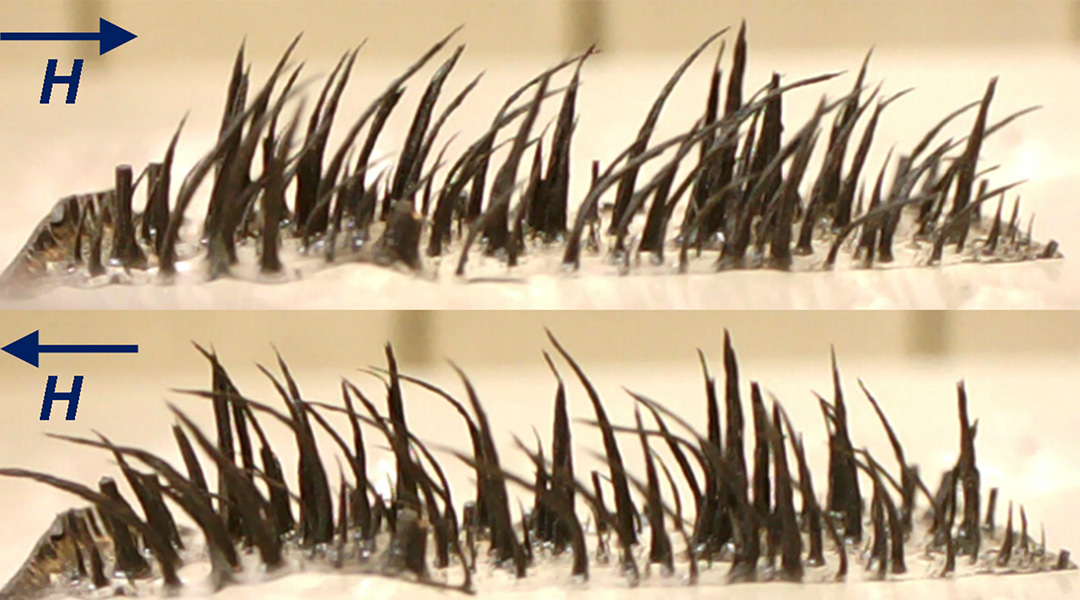Scientists have found a way to make reprogrammable magnetic cilia for the first time, opening doors for their use in robotics, microsensors, and microfluidic devices.
Within the human body, these tiny, hair-like structures shoulder sundry tasks. Present on most human cells, they help keep airways free from mucus, help with egg and sperm motility, or play important sensory roles in the kidney and eye.
While previous research has shown that light, air, and electricity can all be used to trigger the movements of artificial cilia, harnessing magnetism offers several advantages. With magnetic cilia, manipulation and control are more feasible as their movements are driven by an externally applied magnetic field. But reprogramming them after initial use has not been easy.
“Self-assembled cilia have an inherent magnetization that limits their programmability, but [we’ve shown they] can be reprogrammed for new behaviors or applications,” said Joseph Tracy, a researcher at the North Carolina State University. “Reprogramming may be simpler than replacement, and this also aligns with principles of ecology.”
The best of both worlds
Most research on magnetic cilia has focused on soft artificial cilia, which are unable to create their own magnetic field or hold onto magnetization after the external magnetic field is removed. These are made of various polymers mixed with materials that are responsive to external triggers.
Made entirely of materials that can be magnetized, hard magnetic cilia, on the other hand, are better at retaining magnetization. This means they can easily be controlled, even in weak magnetic fields, and their own magnetic field can be programmed to orient in a specific direction, guiding how the cilia move when an external magnetic field is next applied.
Both features are more challenging to carry out with soft magnetic materials. Tracy and his colleagues therefore set out to create magnetic cilia that could be reprogrammed to repeatedly alter their motion, taking the best of each into consideration.
To prepare them, the researchers used magnetic microparticles made of neodymium, iron, and boron. These microparticles were mixed into a polymer solution and then exposed to a magnetic field. As the solvent evaporates, the magnetic microparticles link together to form millimeter-sized cilia that are magnetized in the orientation of the external field. After self-assembling, they are now primed for movement by applying specific magnetic fields using electromagnets and permanent magnets.
“This is an interesting study in which existing pre-programmed magnetic artificial cilia can be demagnetized to make it ready for remagnetization,” said Patrick Onck, a researcher at the Zernike Institute for Advanced Materials of the University of Groningen, Netherlands, who was not involved in the study.
Combining both experimental and computational simulations, he continued, lead to enhanced and complementary insights.
Remagnetizing and reprogramming
To remagnetize the cilia in a different direction, they need to be first immobilized in ice. While the cilia are housed within a cylindrical Teflon boat, they are otherwise unbound. If the cilia are left free-floating, there is a high chance of them unintentionally moving or bending during remagnetization.
“A sequence of magnetic fields is applied to first reduce the initial magnetization in the cilia and then to remagnetize them,” said Tracy, in an email. “After allowing the ice to thaw and the water to dry, the cilia exhibit a new response to applied magnetic fields.”
After the remagnetization process, the cilia move in complex ways — they may coil and release rapidly, in a snapping motion. As Onck alluded, in order to understand these complex movements, the researchers created a computational model and simulated various other environments.
By successfully predicting how the magnetic cilia behave under known conditions, the model could predict how they might behave in untested conditions.
“The main significance of this work is the demonstrated controllability of the de- and re-magnetization of already-fabricated magnetic cilia,” added Onck. “The advantage of this is that existing magnetic cilia can be re-programmed for a task that is different from what it is initially designed for, creating enhanced flexibility in use.”
Reference: Matthew R. Clary, et al., Magnetic Reprogramming of Self-Assembled Hard-Magnetic Cilia, Advanced Materials Technologies (2024). DOI: 10.1002/admt.202302243

















